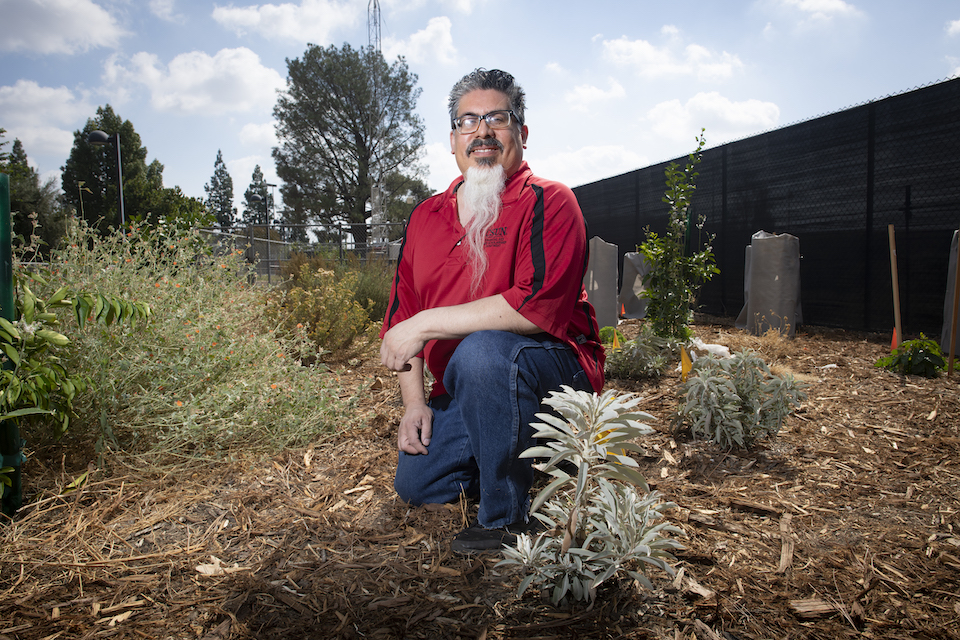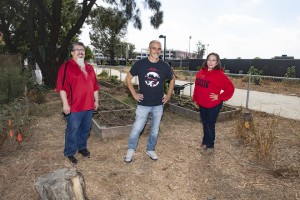New Campus Projects Highlight Native American Presence at CSUN and in the Community

Jesus Alvarez is senator for the Tataviam Land Conservancy and a financial aid assistant at CSUN. Photo by Lee Choo.
“Be the descendant your ancestors would be proud of.”
The phrase coined by Winona LaDuke — an environmentalist and author focused on tribal rights — refers to the importance of a covenant relationship between two parties, a reciprocal relationship where both acknowledge each other as equals and take care of each other.
According to professor Scott Andrews, director of CSUN’s American Indian Studies Program and member of the Cherokee Nation of Oklahoma, this is how Native American people understand their relationship with the land and each other. It’s also the kind of relationship CSUN is working toward achieving with the Fernandeño Tataviam Band of Mission Indians, the historic tribe of northern Los Angeles County, whose ancestral territory includes the land on which the university is built.
From a planned mural in the University Library painted by a Fernandeño Tataviam artist to discussions about the re-naming of campus locations to honor Fernandeño Tataviam traditions, CSUN continues to build on efforts that started with a public land acknowledgement last year, raising awareness and honoring the Native American presence on campus.
“It’s really wonderful to know that there’s a presence of the tribe coming again, and I want to share that with people too,” said Jesus Alvarez, an elected official for the Fernandeño Tataviam Band of Mission Indians, president of the board for the Tataviam Land Conservancy and a financial aid representative at CSUN. “I feel tremendously blessed to just be here to share all of this.”
One of the main projects that’s currently in development involves the Chicana/o, American Indian Studies (AIS) and Central American Studies (CAS) Garden, in the middle of the three programs’ buildings. The goal is to incorporate native plants in the garden and turn it into a resource where people can pick fruits, vegetables and herbs, interacting with native plants like those used by Southern California’s tribes for centuries.
Along with the Chicana/o, AIS and CAS Garden, CSUN’s Institute for Sustainability is also working on introducing more native plants to CSUN, creating Fernandeño Tataviam pockets all over campus with signage that will educate students on the plants and their use by Indigenous peoples throughout history.
Other similar efforts include the addition of workshops where students can learn more about Fernandeño Tataviam traditions and views regarding sustainability and plants, as well as dedicating a section of the Institute’s garden to learning about Fernandeño Tataviam culture. Two hundred native plants can already be found at the Institute’s garden, but organizers plan to keep expanding.
“These indigenous plant zones on campus are a way of bringing the Tataviam knowledge to campus, for the students to be around and see and learn how to relate to the space in a more healthy and respectful way,” Andrews said.

(L-R) Jesus Alvarez, professor Natale Zappia and Mabel Trigueros continue working to incorporate more native plants in CSUN’s Institute for Sustainability Garden.
By taking active steps toward better Fernandeño Tataviam representation on campus, the university is committed to showing that Native American people and culture still play crucial roles in the community and contribute immensely to campus life.
According to professor Natale Zappia, director of CSUN’s Institute for Sustainability, Indigenous knowledge provides a rich background on how to use landscapes in a sustainable and regenerative way by recycling everything, composting food, developing better irrigation methods to conserve water and avoiding the use of pesticides.
These methods are already being incorporated by the Institute for Sustainability in their practices, Zappia said, helping make CSUN a more sustainable campus.
“The idea of connecting with the land, with the ground we work on, is a core component of Indigenous interactions with anything, and these kinds of efforts invite us to take a step back and reimagine our perspective beyond simply acknowledging Indigenous issues,” Zappia said.
At the same time, through the efforts being made, the university is seeking to heal its relationship with the people and the land, recognizing that it was not given willingly, and taking the necessary actions to honor tribal history and tradition.
“A lot of it, at least from my perspective, comes back to healing our relationship with the land,” said Nicole Blalock, assistant professor in the American Indian Studies Program, who is working on the Chicana/o, AIS and CAS Garden project and is a descendent of the Crow, Cherokee and Chickasaw nations. “As we acknowledge and bring the Tataviam in the conversation as partners with what is happening on their land, then we begin to heal that relationship.“

 experience
experience